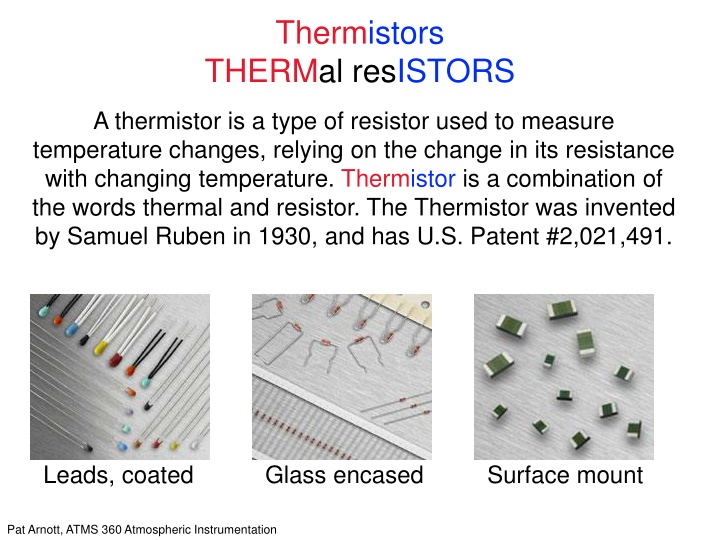
Thermistors: Types and Applications
Learn about thermistors, a type of resistor used for measuring temperature changes by utilizing variations in resistance. Discover the different types of thermistors, their characteristics, and applications in various industries.
Download Presentation

Please find below an Image/Link to download the presentation.
The content on the website is provided AS IS for your information and personal use only. It may not be sold, licensed, or shared on other websites without obtaining consent from the author. If you encounter any issues during the download, it is possible that the publisher has removed the file from their server.
You are allowed to download the files provided on this website for personal or commercial use, subject to the condition that they are used lawfully. All files are the property of their respective owners.
The content on the website is provided AS IS for your information and personal use only. It may not be sold, licensed, or shared on other websites without obtaining consent from the author.
E N D
Presentation Transcript
Thermistors THERMal resISTORS A thermistor is a type of resistor used to measure temperature changes, relying on the change in its resistance with changing temperature. Thermistor is a combination of the words thermal and resistor. The Thermistor was invented by Samuel Ruben in 1930, and has U.S. Patent #2,021,491. Leads, coated Glass encased Surface mount Pat Arnott, ATMS 360 Atmospheric Instrumentation
Thermistors THERMal resISTORS Thermistors are made of semiconductor materials (metallic compounds including oxides such as manganese, copper, cobalt, and nickel, as well as single-crystal semiconductors silicon and germanium). Contrast <<--->> Common carbon resistors, made from carbon powder mixed with a phenolic binder glue. Leads, coated Glass encased Surface mount Pat Arnott, ATMS 360 Atmospheric Instrumentation
Thermistors THERMal resISTORS Assume a simple linear relationship between resistance and temperature for the following discussion: R = k T where R = change in resistance T = change in temperature k = first-order temperature coefficient of resistance Source: http://en.wikipedia.org/wiki/Thermistor Pat Arnott, ATMS 360 Atmospheric Instrumentation
Thermistors THERMal resISTORS Thermistors can be classified into two types depending on the sign of k. If k is positive, the resistance increases with increasing temperature, and the device is called a positive temperature coefficient (PTC) thermistor, Posistor. If k is negative, the resistance decreases with increasing temperature, and the device is called a negative temperature coefficient (NTC) thermistor. Source: http://en.wikipedia.org/wiki/Thermistor Pat Arnott, ATMS 360 Atmospheric Instrumentation
Thermistors THERMal resISTORS Resistors that are not thermistors are designed to have the smallest possible k, so that their resistance remains almost constant over a wide temperature range. Source: http://en.wikipedia.org/wiki/Thermistor Pat Arnott, ATMS 360 Atmospheric Instrumentation
Thermistors THERMal resISTORS Thermistor-choice is based on the nominal resistance you want at the operating temperature range, on the size, and on the time constant. Time constants are about 5 - 10 seconds. (Check this out with your thermistor). Source: http://www.science.uwaterloo.ca/~jddmarti/p352_w2007/Thermistor_50K.pdf Pat Arnott, ATMS 360 Atmospheric Instrumentation
Thermistors THERMal resISTORS Source: http://www.science.uwaterloo.ca/~jddmarti/p352_w2007/Thermistor_50K.pdf Pat Arnott, ATMS 360 Atmospheric Instrumentation
Thermistors THERMal resISTORS Example Applications: 1. Temperature measurement. 2. Time delay (self heating from large current opens the thermistor so it can be used as a slow switch). Heating = i2 R where R is the resistance and i is the current. 3. Surge suppression when a circuit is first energized. Current needs to flow through the thermistor for awhile to heat it so that it opens , and acts again as a switch. Pat Arnott, ATMS 360 Atmospheric Instrumentation
